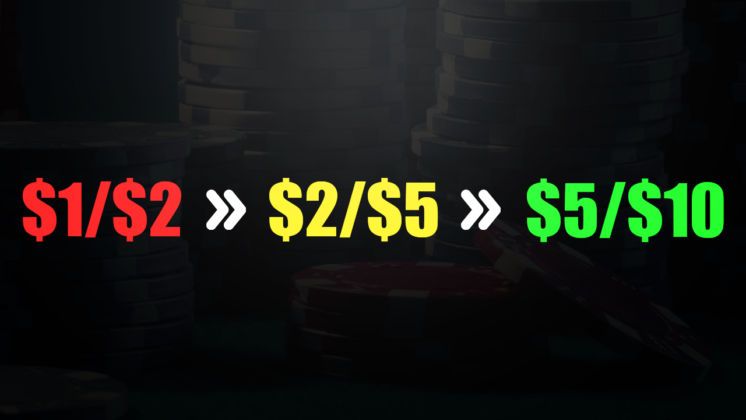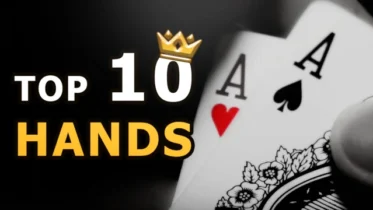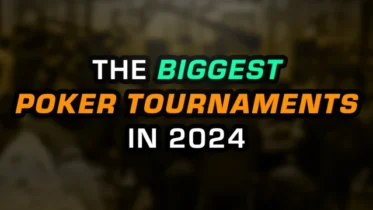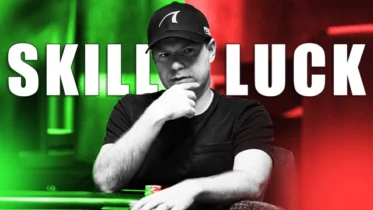It’s the rare poker player who doesn’t dream of moving up to the next bigger cash game. More zeros in the pot sizes, more excitement, the opportunity to boost your bankroll. Just to amplify the desire, we can all watch vlogging heroes such as Andrew Neeme, Brad Owen, and Ethan “Rampage” Yau. They’ve leveled up from the very lowest $1/$2 stakes no-limit hold’em up to absurd oxygen-mask-required nosebleed games, before our very eyes.
Surely we can all be forgiven for wondering if we could be the next ones to climb Parnassus like that.
Okay, let’s stipulate it’s possible. How do we go about actually getting there? I present here three signs that you might be ready to move up stakes at your, ah, current stake, and take a permanent seat in the next bigger game.
We’re not talking about “taking a shot.”
The first important clarification is that we’re not talking about taking a shot. “Taking a shot” is deciding that the stars have aligned to go try a bigger game than you’re used to playing. Maybe you had a quick triple-up in your regular cash game, still have a few hours to play, and see a couple of known fish in the higher stakes game. That’s when you put your name on that list and take a shot. You don’t know if you’re ready for the game or not, but there’s only one way to find out…
Taking a shot is a necessary precursor to officially and “permanently” moving up in stakes, but here we’re discussing how you know when you’re ready to move up for keeps.
Here are three important signs:
- Your bankroll, whatever that means, is prepared for the swings.
- Your brain and stomach are prepared for the bigger numbers.
- You consistently and reliably spot multiple, expensive errors by players at the higher stakes.
Your poker bankroll is ready for the swings
It doesn’t matter if you have a “real” poker bankroll as a professional or serious semi-pro would have, or simply use discretionary funds from a job or other income source. That pot of money is going to experience bigger swings when you settle into a higher stakes game.
Let’s take the example of Carrie, who is a pediatrician in the daytime, but takes her cash game pursuits as seriously as she does her young patients. She has set aside $10,000, which is her $1/$3 “bankroll.” Everything that goes to the casino comes from that bucket of money, and everything that she cashes in at the end of the session goes back into the bucket. She has a deal with herself that if the bucket goes to zero, she won’t play again until she is able to carve another $10,000 bankroll out of discretionary funds.
This, by the way, is excellent discipline and is a key skill to be a pro or semi-pro player.
Carrie has taken a couple of shots at the $2/$5 game, which has a max buy-in of $1,000, and she’s up a net $800 on her $2/$5 exploits. That’s fine, but $10,000 will not support playing the $2/$5 game regularly. For instance, in one unfortunate session, she lost $1,400. This didn’t hinder her ability to play in her regular $1/$3 game, but a couple of such sessions in a row would knock her out of serious $2/$5 contention, and perhaps endanger her $1/$3 play.
Carrie believes that she is a winner in the $2/$5 game – in fact, a bigger winner than she is in the $1/$3 game. And she’s ready to make that her permanent home. But to do so, she really needs $20,000. She has two choices:
- Wait until her $1/$3 winnings push her bankroll over the $20k mark, and/or
- Invest further discretionary money from her career into her poker bankroll.
There’s no right answer – either approach (or a combination) is just fine. What is not okay, is for Carrie to try to be a $2/$5 regular on a $10k bankroll – it will end poorly.
It’s fine to take shots at a bigger game on your current bankroll. It is financially irresponsible to play the bigger game regularly when bankrolled only for the smaller game.
Note that the numbers I used in the example above are for discussion purposes only. There are great resources to guide your bankroll requirements, and you should use those to decide how much you need for your game (both the smaller and larger stakes).
Your brain and stomach are ready for bigger numbers.
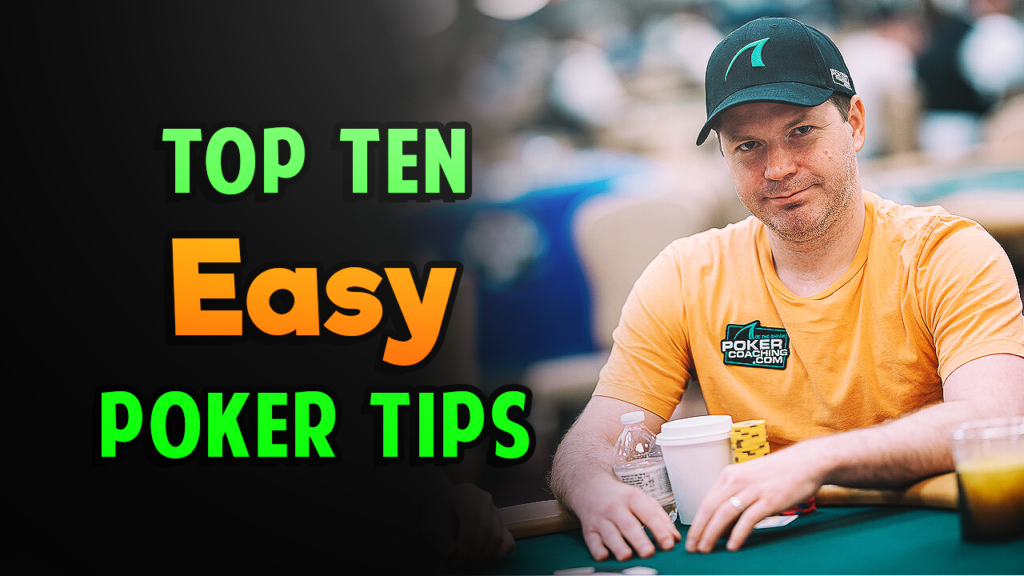
Crush cash games and poker tournaments with Jonathan Little’s Top Ten Poker Tips!
You can keep your head cool at the cash game table
First, let’s talk about your brain, because that’s the easier one. I still remember one of the first times I tested the $2/$5 waters, after being a $1/$2 and $1/$3 regular. I opened some hand – I don’t even remember what – to $20. There was one call behind me, then the pro in the small blind made it $110.
I thought, “A hundred and ten dollars!?!?!” That was, after all, half a stack in my usual $1/$2 game. But here at the $2/$5 stakes, it was a perfectly reasonable, well-sized 3-bet.
The first few times you play a bigger game, the absolute numbers will affect you – it’s inevitable. One good way to overcome this “sticker shock” is to focus on big blind units. It’s not $25 – it’s a 5x open; it’s not $60 – it’s a half-pot bet, so I’m getting 3:1 odds.
Keep your stomach calm
Your stomach will probably be a bigger issue than your brain.
The pots will be bigger – both the ones you win, and those you lose. When you run kings into pocket aces (or your aces get cracked by kings) the pain is doubled, or worse. Again, try to divorce yourself from the dollar amounts (“I just lost a $2,000 pot”), and focus on the game units (“I lost one buy-in”).
You will have your biggest winning session and your biggest losing session. Every time you move up, you reach new highs and new lows. Consider this screenshot from the YouTube home page for vlogging phenom Mariano Gandoli:
Mariano is an excellent poker player, and yet, with every step up in stakes, he plumbs new record lows. I have not escaped that effect, and neither will you.
One absolute requirement for moving up in stakes is the ability to emotionally handle the inevitable bigger losses.
When you can suffer a big – even for the new higher stakes – loss, and shrug it off as another day at the office, it’s a good sign that you’re ready to play there regularly.
Now, here’s a tip that uses the first concept to address the second:
If your bankroll is absurdly big for the stakes you’re playing, your head and stomach will stay much cooler and calmer.
Let’s go back to our pediatrician friend, Carrie. Suppose that, instead of $10,000 in her “bankroll,” Carrie has $50,000.
Now Carrie takes a shot at the $2/$5 game, and loses $1,400, but it makes nary a dent in her bankroll. If she reaches a point where she is mentally comfortable with the bet and pot sizes in the $2/$5 game, her stomach will be in fine shape. Furthermore, if she wins $1800 in a session, she’s less likely to go on “winner’s tilt” (e.g. run out and buy a new TV). It’s just a nice 3.6% boost to her bankroll.
“If your bankroll feels way too big, that’s just about right.”
–Tommy Angelo
You consistently see your opponents making big mistakes
When you take a shot at a new, bigger game, you have plenty of things to concentrate on – your nerves, the bigger bets, all of it. But as you start to take more shots, and think about making this game your new home, you need to be seeing mistakes – big ones.
Now here’s where it gets interesting. All poker players make mistakes. But the better ones make fewer mistakes, and the mistakes they do make are smaller. So for you to be a winner in this bigger game, you need to recognize the mistakes that the players are making.
Good news: Most live poker games are full of players making big mistakes.
Bad news: If you can’t spot those mistakes, you’ll never beat the game.
The most famous saying in poker: “If you can’t spot the fish in 30 minutes, you are the fish.”
I’m not going to tell you what mistakes to look for, because they will vary with your player population and the stakes involved. Also, well, that’s your job – I wouldn’t be doing you any favors to hand you all the potential mistakes on a silver platter.
If you see your opponents making mistakes, excellent. Pay attention to what they are, and who’s making them, particularly if that person is a regular in the game. Ask yourself how you will exploit that mistake. Figure out the general population mistakes, and also specific mistakes that certain players make.
Now you’re ready to make this bigger game your new permanent home – congratulations.
Are you not spotting cash game mistakes?
If you don’t spot mistakes, then you’re not ready to move up. Let’s say you’re a winning $2/$5 regular and decide to see if you’re ready for the $5/$10 game that runs Thursday through Saturday every weekend. You play it a couple of times, and mostly break even, but you don’t see the mistakes that are common in the $2/$5 game.
Now we have a small problem. If you just sit and play in the $2/$5 game, you’ll keep seeing the same mistakes your fellow $2/$5 players have been making all along. That won’t help you find the mistakes in the $5/$10 game.
So get to the lab. PokerCoaching is chock full of training materials – find the ones that are applicable to the $5/$10 game. Study with GTO Wizard or Hybrid Poker. Get a coach and take some lessons from them. I promise you, the $5/$10 players are making mistakes, and likely some doozies. You can move up to that game – you just have to study somewhere other than the $2/$5 game.
Have patience, and confidence – you will get there.
Welcome to your new home
- Your bankroll is far too big for this new game you’re playing – Tommy Angelo and I think that sounds perfect.
- Your stomach and head are copasetic with the bet sizes, pot sizes, and session results. Not least because your bankroll is far too big.
- At the table, you observe an aquarium full of mistake-makers. Everywhere you look, you see playing errors that make you think, “That’s money in my pocket.”
Congratulations, and if you ever find yourself playing on a live stream for nosebleed stakes, drop me a note and let me know what it’s like.
